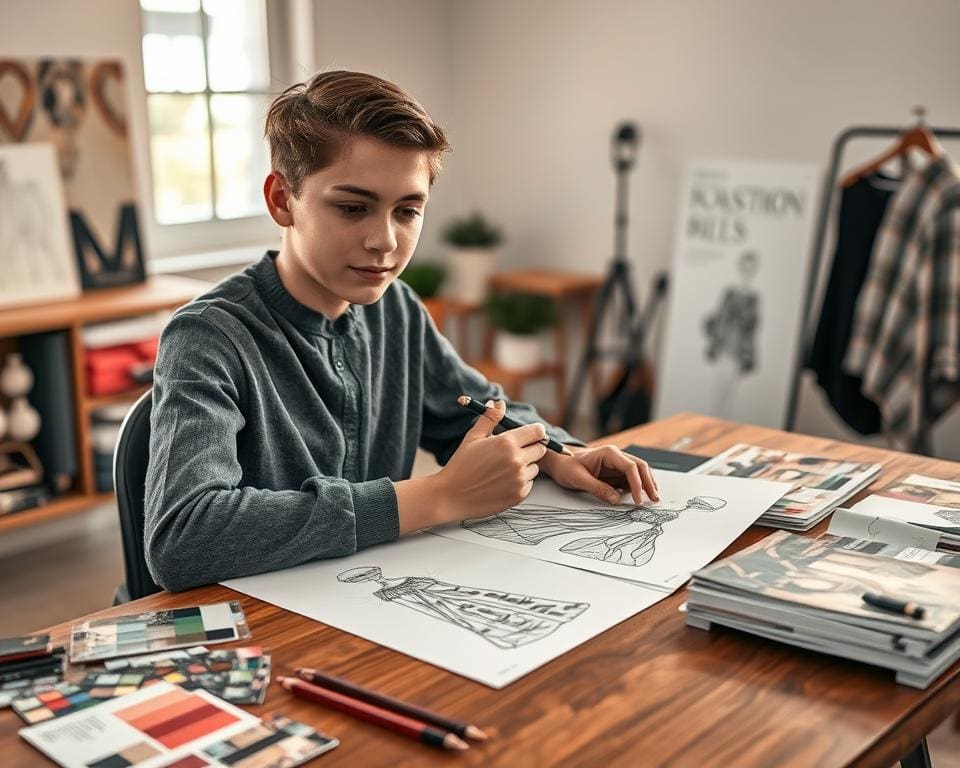Embarking on a journey to become a fashion designer at 15 can be both thrilling and daunting. The fashion industry is brimming with opportunities for creative minds, and many renowned designers, such as Alexander Wang and Coco Chanel, began their illustrious careers at a young age. This article aims to guide aspiring teenage fashion designers through the essential steps and resources they need to kick-start their fashion design career at 15. With passion and determination, you can carve out your unique path in an ever-evolving world of style.
Understanding Fashion Design: An Introduction for Teens
Fashion design serves as a creative outlet for countless individuals, particularly teenagers eager to express themselves. Those pursuing fashion designing at 15 should grasp the fundamentals of the field, encompassing both artistry and practicality.
What is Fashion Design?
Fashion design is the process of creating clothing and accessories, blending aesthetics with functionality. It involves not only sketching designs but also understanding materials, fabric properties, and the latest market trends. A young designer must consider cultural influences and innovate, bringing fresh ideas to life. Learning these aspects forms a strong foundation in fashion education for teens.
The Importance of Personal Style
Embracing personal style is essential for young designers. It is this unique perspective that sets them apart from others. A clearly defined personal style contributes to a designer’s brand identity and makes a significant impact in a competitive market. By experimenting with various looks and inspirations, teens can discover their individual voice, which ultimately enhances their fashion designing journey.

How To Become A Fashion Designer At 15
For aspiring young fashion designers, identifying passion plays a crucial role in shaping their creative journey. Understanding what aspects of fashion resonate most can enhance their motivation, guiding their steps in this vibrant industry. Whether it’s through sketching, sewing, or analysing current trends, engaging in diverse fashion-related activities can provide clarity on one’s true interests.
Identifying Your Passion for Fashion
To become a successful young fashion designer, it is essential to explore various dimensions of the fashion world. Try attending local fashion shows or workshops that showcase emerging talent. Reading reputable fashion magazines can spark inspiration and keep you updated on trends. Engaging in activities like creating mood boards or experimenting with your style can also aid in identifying passion. Each experience offers valuable insights into what resonates most within the realm of fashion.
Essential Fashion Design Skills for Teenagers
Acquiring key fashion design skills for teenagers lays the foundation for a promising career in fashion. First and foremost, creativity is paramount; it fuels innovation and original ideas. Developing strong technical skills in sewing and pattern making ensures that your designs come to life effectively. Understanding the fundamentals of market analysis helps in recognizing consumer needs, which is vital for a successful fashion business.
Communication and presentation skills cannot be overlooked. These abilities prepare young fashion designers to articulate their ideas clearly and confidently, whether during collaborations or interviews. Emphasising these essential skills will pave the way for tomorrow’s leaders in the fashion industry.
Education and Resources for Young Fashion Designers
Embarking on a journey in fashion design requires a solid educational foundation. Young aspiring designers have several choices when it comes to their learning paths. Exploring options such as fashion-focused schools, workshops, and community college courses can provide invaluable insights and skills essential for success in the industry. Understanding the differences between various educational routes will allow teens to make informed decisions about their future in fashion.
Fashion Education for Teens: Where to Begin
For those beginning their journey in fashion education for teens, it is crucial to start with the basics. Foundational courses in art, sewing, and business skills can enhance creativity and technical knowledge. Many traditional schools offer specialised programmes that can prepare students for more advanced studies. Additionally, local workshops can supply hands-on experience that enriches a teen’s understanding of the fashion landscape.
Online Courses vs. Traditional Schools
The debate between online courses and traditional schools often arises for aspiring young fashion designers. Online platforms like Coursera and Skillshare provide flexible learning opportunities with a vast array of resources. This model allows students to learn at their own pace and explore topics that pique their interest. On the other hand, traditional schools offer structured learning experiences and networking opportunities that can be essential in building relationships within the industry. Each method has its advantages, so understanding individual goals will help determine the best fit for aspiring designers.
Gaining Experience in Fashion Designing at 15
Embarking on a journey in fashion design at a young age presents a unique opportunity to build a solid foundation for future success. Gaining experience is crucial, as it allows aspiring designers to immerse themselves in the industry. Practical engagement, such as internships and volunteer work, enhances understanding while fostering essential connections.
Internships and Volunteering Opportunities
Internships serve as an excellent avenue for young designers to gain hands-on experience. Local boutiques and designers often welcome eager interns who are enthusiastic about fashion. Volunteering at fashion events or with established brands can significantly broaden one’s knowledge of the industry. Reaching out to these entities can lead to valuable learning experiences, making the journey into fashion more immersive.
Creating a Fashion Portfolio
A strong fashion portfolio becomes a young designer’s calling card. This collection should feature a variety of work, including sketches, completed projects, and mood boards. Showcasing creativity and skill through a fashion portfolio provides an edge when seeking internships or jobs. Regularly updating this portfolio with new projects reflects growth and dedication within the fashion realm.
Networking in the Fashion Industry
Networking plays a pivotal role in establishing a career in fashion. Young designers can leverage social media platforms like Instagram and LinkedIn for engagement with industry professionals. Attending fashion events and workshops enables face-to-face interactions, allowing for the development of meaningful relationships that can benefit their careers. By building a network early on, young designers position themselves for future opportunities in the industry.
Starting a Fashion Brand at 15: Tips and Strategies
Embarking on the journey of starting a fashion brand at 15 is a thrilling venture filled with opportunities. To successfully launch your brand, it’s pivotal to first identify your target market and determine your niche. Understand the demographics and preferences of your potential customers, as this insight will guide your design approach and product offerings. By defining a unique selling proposition, you can carve out a distinct identity in the fashion landscape, allowing your brand to stand out.
One of the essential fashion brand strategies involves crafting a solid business plan. This plan should encompass your vision, financial projections, and marketing strategies. Consider utilising social media platforms like Instagram and TikTok for marketing, as they offer invaluable tools for engaging with your audience and showcasing your designs. Additionally, explore e-commerce platforms to facilitate the sale of your creations, making it easier to reach customers nationwide.
As you venture into this competitive industry, cultivating entrepreneurial skills is crucial. Embrace the spirit of perseverance and prioritise continuous learning, whether through online resources or seeking mentorship from established fashion professionals. Building a network within the industry can provide guidance and support, helping you navigate challenges as you work towards turning your fashion dreams into tangible reality.









